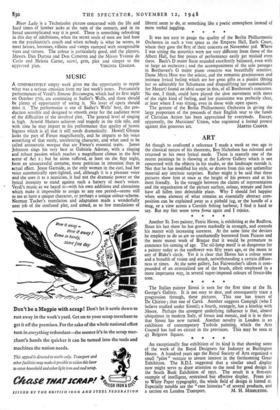ART
As though to confound a reference I made a week or two ago to the classical nature of his theorems, Ben Nicholson has relented and returned to his most lyrical mode. There is scarcely one of the recent paintings he is showing at the Lefevre Gallery which is not concerned with the objects in his studio, or the landscape outside it. Not that he has modified his style, or drawn from this not unfamiliar material any intrinsic surprises. Rather might it be said that these pictures show him at once at the height of his powers and at his most friendly. In the struggle between the claims of representation and the organisation of the picture surface, colour, texture and form have all fallen into delectable place. Why I should feel happier when some element of what remains an essentially abstract com- position can be explained away as a piebald jug, or the handle of a mug, or a view across a Cornish fishing harbour, I find it hard to. say. But my feet sense terra firma again and I rejoice.
Another St. Ives painter, Patric Heron, is exhibiting at the Redfern. Since his last show he has grown markedly in strength, and controls his matter with increasing sureness. At the same time the devices he employs to do so are so unashamedly borrowed from Picasso and the more recent work of Braque that it would be premature to announce his coming of age. The oil-lamp motif is as dangerous for a painter today as the sunflower was fifty years ago, or the moon to any of Blake's circle. Yet it is clear that Heron has a colour sense and a breadth of vision and attack, notwithstanding a certain diffuse- ness at times. At the same gallery, Ian Fairweather's idiom is com- pounded of an orientalised use of the brush, albeit employed in a more impetuous way, in several super-imposed colours of fresco-like tone. * * * * The Italian painter Sironi is seen for the first time at the St. George's Gallery. It is not easy to date, and consequently trace a progression through, these pictures. This one has traces of De Chirico ; that one of aura. Another suggests Campigli (who I believe studied under Sironi); a fourth, strangely, has a kinship with Moore. Perhaps the strongest underlying influence is that, almost ubiquitous in modern Italy, of fresco and mosaic, and it is to these that Sironi has now turned. Another novelty in London is an exhibition of contemporary Turkish painting, which the Arts Council has had on circuit in the provinces. This may be seen at 43 Belgrave Square. * * * *
An exceptionally fine exhibition of its kind is that showing some of the work of the Royal Designers for Industry at Burlington House. A hundred years ago the Royal Society of Arts organised a small ."pilot" venture to arouse interest in the forthcoming Great Exhibition. The R.D.I. suggested that a similar small display now might serve to draw attention to the need for good design in the South Bank Exhibition of 1951. The result is a first-rate example of intelligent,' restrained but effective display. From jets to White Paper typography, the whole field of design is hinted at. Especially notable are the "case histories" of several products, and
a section on London Transport. M. H. MIDDLETON.


































 Previous page
Previous page